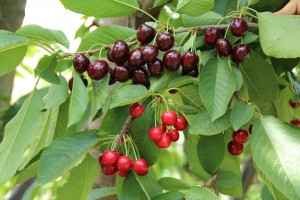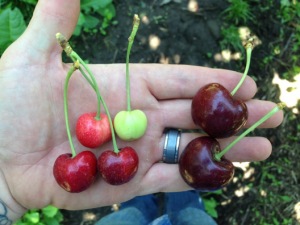Written by: Tianna DuPont, WSU Extension; Scott Harper, WSU Plant Pathology; Andrea Bixby Brosi, Betsy Beers, WSU Entomology. Updated May 2019. Updated April 2020. Updated June 2020.
Little cherry virus 2 (LChV2) and Little cherry virus 1 (LChV1), and X-disease phytoplasma, cause small cherry symptoms often described as ‘Little Cherry disease’, ‘X-disease’ or Western X. Diseased trees produce cherries of small size and poor color and flavor making the fruit unmarketable.
Background
Little Cherry Disease is not a new problem in the Pacific Northwest. The first major epidemic occurred in the Kootenay valley in Canada in 1938, and over the following 40 years devastated the Canadian cherry industry so much that by 1979 the last packing line in the Kootenay valley closed, and the Canadian industry has spent the last 40 years rebuilding.
In Washington State the last major epidemic occurred in the late 1940s and into the 1950s, resulting in the removal of significant acreage. But, with the passage of time and changes in management practices, the disease has become prevalent in Washington orchards again. Since 2010, LCD has become a statewide problem, resulting in unpicked limbs/trees, tree removal, and even orchard removal.
Symptoms
Little cherry virus (both -1 and-2) infection of sweet cherry cultivars results in small fruit with reduced sugar content that may taste bland or insipid. Severity of the disease differs between cultivars, with Lambert and Bing being highly susceptible, whereas Van and Sam are less so and fruit may reach marketable size although flavor is still affected. See symptoms gallery.
On some cultivars such as Lambert, the fruit may also have a noticeable pointed tip. Tree size and vigor are not significantly affected, and there are no reliable foliar symptoms associated with this disease. The disease develops over several years:
- Years 1-2: small fruit may be restricted to one branch, or cluster, fruit color may develop normally, or individual off-color fruit may be observed.
- Years 2-3: systemically infected tree, small fruit observed on multiple or all limbs, and poor color development is pronounced.
- 4+ years: cultivar dependent, but characterized by reduced fruit yield. False recovery may occur in less-susceptible cultivars, producing normal-sized fruit that lack flavor.
Causal Organism
In Washington State, Little cherry virus-2 and X-disease phytoplasma are the major causes of little cherry symptoms. Little cherry virus-1 is also present, however it is rare and does not appear to be spreading. Little cherry virus-2 is a member of the virus family Closteroviridae.
Occurrence
Little cherry virus-2 is present throughout Washington State, and is also present in British Columbia in Canada.
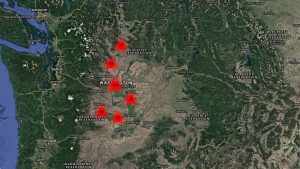
Impact
More than 238,856 trees equivalent to 974 acres of sweet cherries have been removed due to X-disease and Little Cherry Disease between 2015 and 2020 according to a recent survey conducted by WSU/ OSU Extension (Molnar, 2021). Removed trees reduced revenue to the industry by an estimated $30 million in 2020 and $65 million between 2015 and 2020. Over the seven-year re-establishment period estimated lost revenue and establishment costs to growers is approximately $115 million.
Host Range
The host range of Little cherry virus-1 and -2 is limited to a few species within the genus Prunus. Sweet cherry (Prunus Avium) and sour cherry (P. cerasus) are the most economically important hosts of this virus, although it can also infect ornamental flowering cherries (P. mahaleb, P. emarginata, and P. tormentosa).
Transmission
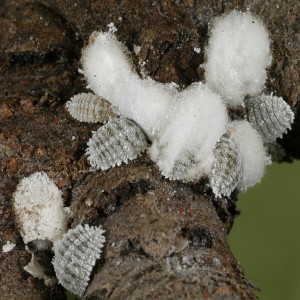
Little cherry virus-1 and -2 can be readily transmitted by all types of grafting, including top-working and root-grafting between neighboring trees. Little cherry virus 2 is also transmitted by apple (Phenacoccus aceris) and grape (Pseudococcus maritimus) mealybugs; there is no known insect vector for Little cherry virus-1.
Sampling and Testing
Material to sample:
Submit four five-inch cuttings from the diseased limb(s) including leaves, and FRUIT STEMS.

Where to sample:
Trees with symptoms: Sample from symptomatic limbs.
Trees with no symptoms: Sample from each leader. *Samples only needed in non-confirmed blocks/ adjoining trees.
When to sample:
The week before harvest to mid-August.
Sample condition:
Keep tissue moist and cool (e.g. package with a cold pack). Old or dried tissue is more likely to have false negatives.
Where to send samples:
See labs page
Download scouting and sampling flier here.
English [pdf]
Español [pdf]
Controls
Pathogen-Free Planting Sources
Replacement trees must be obtained from pathogen-free planting stock. Nursery trees can be free of symptoms and still be infected. Manage your risks. Use certified material. If in doubt, have the material tested before you buy or plant.
Remove Infected Trees
Once little cherry disease is confirmed in an orchard all trees showing visual symptoms, and/or those that have tested positive, should be removed. Little cherry virus-1 and -2 survive in living plant tissue, therefore it is critical to kill or remove cherry roots in order to stop re-infection from occurring when
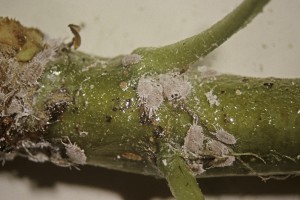
new young trees root graft with infected plant roots. Treat stumps with herbicide immediately after cutting or inject into trees before cutting trees to ensure roots are dead. Apply insecticide before tree removal to reduce the risk of infected insects moving from the infected tree to neighboring trees when trees are removed. For details see BMPs for Tree Removal.
Control Vectors
Detect Mealybug Populations
Egg masses of both mealy bug species can be seen on bark, typically near the center (trunk) off the tree. Pulling back loose bark in search of egg masses is another strategy. Apple mealybug adults can be seen feeding in cracks and crevices of bark during the early spring, and crawlers can be found on the undersides of leaves during June, July and August. Grape mealybug crawlers and adults are typically found feeding at the base of fruiting clusters before harvest. When populations are low, it is common for both species of mealybug to reside only in the tops of trees in the un-pruned suckers, making their presence difficult to detect.
Identify your mealybug populations
In order to best target control measures, start by identifying your mealybug population. The two mealybug species differ in appearance as well as lifecycle. Apple mealybug are yellow/green in appearance and egg masses are cigar shaped, while grape mealybug is pink/purple with two tails and egg masses appear fluffy. Apple mealybug has one generation per year with females emerging from overwintering sites in mid-spring. They lay egg masses around June, and crawlers emerge over the course of an entire month. This long/gradual emergence makes the crawler stage difficult to control with foliar sprays. Grape mealybug has at least two generations per year and at some point in the summer; eggs, crawlers, and adults are all present on the same tree, which makes control challenging.
Biological Controls
Beneficial insects including lacewings, minute pirate bugs, spiders and ladybeetles are generally quite effective in controlling mealybugs in orchards where their populations have been conserved. Conserve your natural enemy populations by choosing sprays which minimize impact on predators and parasitoids. The parasitoid wasps Anagyrus schoenherri, Acerophagus notativentris and Pseudophycus angelicus may also contribute to biocontrol. Multiple emergence holes in grape mealybug mummies can easily be seen using a hand lens.
Mealybug Chemical Control
Researchers tested several approaches to controlling the apple mealybugs: delayed dormant pesticide applications to intercept overwintering females; systemic petal fall applications to target crawlers; and foliar summer sprays timed when 70 percent of the crawlers are estimated to have emerged. In a 2014 trial, a combination of Lorsban and oil was found to be most effective at the delayed-dormant stage. Diazinon worked best at controlling the newly hatched crawlers later in the summer. In a 2015 trial results were similar, with one addition: a combination of Centaur and oil also was effective at the delayed-dormant stage. Lorsban is rated as high toxicity on natural enemies. No ratings were found for Centaur. For grape mealybug, in one field trial Azadirect and Mpede provided no difference in crawlers and viable eggs. In one greenhouse trial Centaur, Admire Pro, and Aza Direct reduced crawlers to 0 or near 0. Ultor did not significantly reduce GMB numbers. In general, delayed dormant oils were not as successful as hypothesized.
Additional information
X-Disease Phytoplasma (Western X)
X-Disease and Little Cherry Virus Scouting and Sampling
X-Disease and Little Cherry Virus Scouting and Sampling Guide
BMPs for tree removal for X disease and Little Cherry Virus infected trees
Case studies on tree removal for X-disease phytoplasma and Little cherry virus. DuPont, S.T., Strohm, C., Molnar, C., Naranjo, R., Bishop, G.,Fruit Matters. August 8, 2020.
FSA Tree Assistance Program Offers Support for Little Cherry Tree Removal. DuPont, S.T., Fruit Matters. August 8, 2020.
Questions and Answers on Insect Vectors of X-disease Phytoplasma. Molnar, C., Northfield, T., Fruit Matters. August 5, 2020.
X-disease phytoplasma vector management for 2020. DuPont, S.T., Northfield, T., Fruit Matters. July 7, 2020. Updated Aug 20, 2020.
Gestión de vectores de fitoplasma X para 2020. DuPont, S.T., Northfield, T., Naranjo, R., Sallato, B. Fruit Matters. July 1, 2020.
Síntomas de Fitoplasma X en Frutas de Hueso. Naranjo, R., Molnar, C., DuPont, S.T., Harper, S. Oct, 2020.
Videos
Symptoms of X-disease Phytoplasma in Stone Fruit. Naranjo, R., Molnar, C., DuPont, S.T., Harper, S. Oct, 2020.
X-disease Vector Management Trials. Marshall, A., Northfield, T., Naranjo, R., DuPont, S.T. Aug, 2020.
X-disease Vector Management. Northfield, T., DuPont, S.T., Marshall, A., Naranjo, R. Aug, 2020.
Manejo de Vectores de Fitoplasma X (X-disease Vector Management). DuPont, S.T., Northfield, T., Naranjo, R. July 2020.
Síntomas de Fitoplasma X y Little Cherry Virus. DuPont, S.T., Harper, S., Wright, A., Bishop, G. June, 2020.
Symptoms of Little Cherry Virus and X-disease Phytoplasma. DuPont, S.T., Harper, S., Wright, A., Bishop, G. June, 2020.
Contacts
Department of Plant Pathology
Washington State University
509-786-9230 or scott.harper@wsu.edu
Tianna Dupont, WSU Extension (509) 293-8758 tianna.dupont@wsu.edu
Bernardita Sallato, WSU Extension (509) 439-8542 b.sallato@wsu.edu
Ashley Thomson, OSU Extension (541) 296-5494 Ashley.Thompson@oregonstate.edu
References
Jelkmann and Eastwell (2011) Little cherry virus-1 and -2. In: Virus and virus-like diseases of pome and stone fruits. APS Press, Minnesota, MN.
Bixby-Brosi, AJ, E Beers. 2017. Chemical control of grape mealybug, 2016. Arthropod Management Tests. 42 (1).
Bixby-Brosi, AJ, E Beers. 2015. Chemical control of apple mealybug, 2014. Arthropod Management Tests. 40 (1).
Molnar, C., DuPont, S.T., Thompson, A., Sallato, B., 2021. Estimated Impact of X-disease and Little Cherry Disease in Washington and Oregon from 2015 to 2020. Journal of Extension submitted 3.14.2021.
treefruit.wsu.edu webpages may only be republished with prior author permission © Washington State University. Republished articles with permission must include: “Originally published by Washington State Tree Fruit Extension Fruit Matters at treefruit.wsu.edu” along with author(s) name, and a link to the original article.
